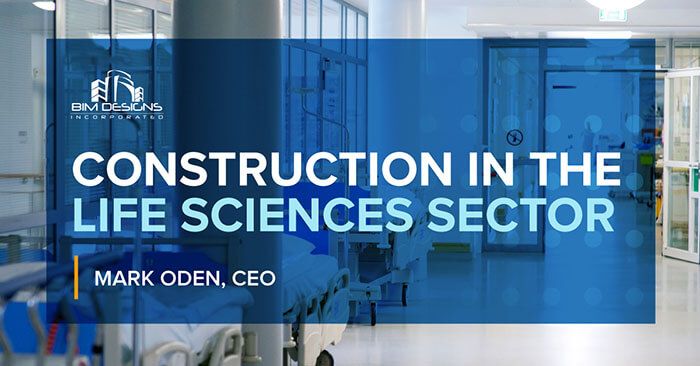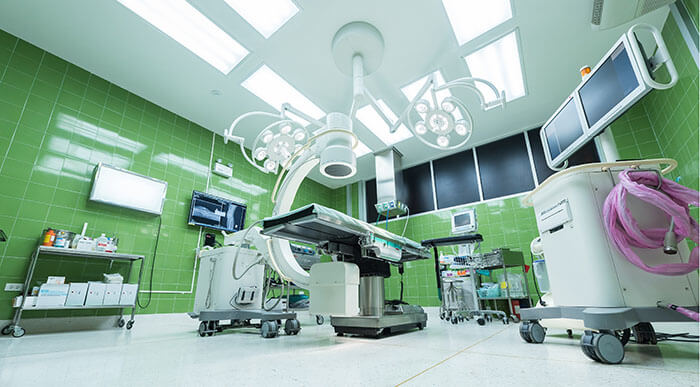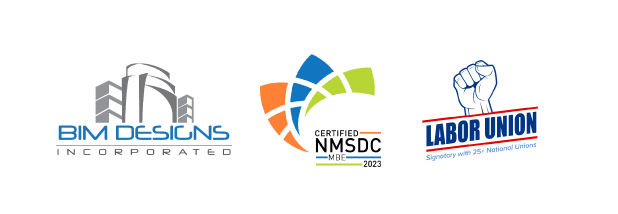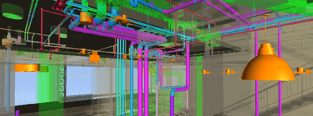
The life sciences sector is one of the hottest growth areas for construction, one of five sectors expected to “explode” this year by one estimate.
Healthcare facilities are large, complex, and expensive projects. BIM, a process and technology, creates a working virtual model and information about the facility, like size, shape, location, and orientation of elements, that can be updated and used at all design and construction stages. Changes made by one team are immediately available to others, an efficient and money-saving improvement over working with multiple paper specs. Whether offsite or on, the build data is correct.
The supply chain issues and labor shortages that have rocked the world during the pandemic have also affected healthcare. Still, COVID-19 and vaccine research have driven growth which is not expected to plateau anytime soon. Add in an aging population and the millions of surgeries, procedures, treatments, and preventive care appointments that were postponed due to COVID-19, and it’s easy to think that it could take years for healthcare to catch up and return to previous levels of operations, if ever.
The predicted explosion in the life sciences sector in construction includes repurposing of buildings affected by the pandemic and construction of new ones. Laboratory construction especially is expected to increase. The push to recover from the pandemic means getting projects to market quicker is now a more significant priority than cost.
Current Construction Needs in Healthcare
Growth in vaccine development is driving the need for new laboratory spaces. In turn, these facilities have specifications that require extensive facilities and capital investments.
In the post-pandemic business world, repurposing may turn out to be a larger market than new builds. Private developers and established life sciences companies experiencing growth are looking for square footage in rentable space. In addition, office spaces left empty in the new work-from-home culture are being repurposed into lab spaces with a need for restaurants, outdoor spaces, fitness centers, and other amenities.
Where Are the Big Markets?
Boston remains the center of life sciences development. But, according to Construction Dive, the needs already outgrow current plans, which notes a demand of about 30 million square feet of lab space compared to 8 million square feet currently teed up.
Companies in life science hubs San Diego and the San Francisco Bay area are already favorites, with venture capitalists looking to invest in the next big medical breakthrough. However, emerging markets New York City, Washington D.C., Denver, and Seattle also expect to see a surge in lab construction. As a result, projects and opportunities will abound in these areas for years to come.
 How Does Design Impact Healthcare?
How Does Design Impact Healthcare?
Healthcare design isn’t just about equipment placement and workflow, though. Design can impact patient care standards and perceptions of care. For example, private rooms with amenities like showers and individual heating and cooling controls make a more comfortable stay. Other considerations include clear wayfinding to help patients, and visitors navigate the building with confidence and spaces dedicated to meditation, prayer, or different spiritual needs.
Patients and families visiting the facility may be doing so under severe emotional stress. BIM processes and tools can help you design spaces that provide a soothing environment that communicates care and competency.
Staff, too, have needs to consider. From intuitive room layouts to equipment and rest areas, careful design can improve efficiency and patient safety and contribute to an overall higher quality experience for both staff and patients.
What Can BIM Designs, Inc. do for Your
Healthcare Project?
Using BIM tools and processes in healthcare projects has all the benefits of any BIM project with an added benefit particular to the healthcare space. BIM creates healthier spaces using 3D capabilities in design ensuring best equipment placement and mobility support, supporting flexibility without disrupting patient care, and identifying issues in code compliance.
Patients and healthcare professionals benefit when BIM is involved in a healthcare build. At BIM Designs, Inc., we’re committed to delivering every project quickly, cost-effectively, and with BIM-optimized quality and constructability.
Our BIM services enable our clients to:
Design Better
Real-world elements scanned to produce computer-generated visuals are used to communicate design details and intent. For example, one working model reduces miscommunication between architects and contractors instead of multiple blueprints. As a result, architects, contractors, and civil engineers can communicate, coordinate, and ensure the design is as visualized.
Build Faster
The complexity of healthcare builds tends to slow them down. BIM speeds construction from beginning to end with computer-generated visualization, coordination of schedules, and better planning.
Efficiency in clash reduction, risk management, supply chains, administration of spatial requirements, and coordination of construction schedules decreases errors and rework, bringing the project to market faster.
Manage coordination and planning
The complexity of a healthcare facility requires expert planning and execution. BIM keeps all teams on the same page and informs planning and coordination of every stage from material quantities through fabrication and construction.
 Lower costs
Lower costs
BIM makes more accurate materials orders, reduces downtime, and streamlines the entire process with superior collaboration and communication. Early and frequent collaboration between design and construction allows complex processes to be managed efficiently and communicated directly using the virtual design and construction efficacies of BIM.
BIM reduces waste in the supply chain, talent, resources, and onsite activities and reduces the need for rework, which equals saving time and money.
Reduce rework
Clash detection and resolution early in the design phase saves time and reduces the need for rework later. In addition, when every detail of a project exists on a single model, risk identification and clash detection are improved, reducing the cascading adverse effects on the construction process of an undetected error.
Optimize space
Spatial requirements and equipment layout are critical considerations where diagnostic, testing and treatment-related equipment are needed. BIM provides specs and visualization, providing an opportunity to get input from clinical staff familiar with needs related to room layout, operations, and workflow.
Precise documentation of a building facilitates building management and future changing spatial requirements, renovations, or refurbishment of all or part of the building.
BIM Designs, Inc. and Healthcare
Healthcare design and construction are complex and critical, which is why it can realize significant benefits from the BIM process and technology.
BIM Designs Inc. has collaborated with leading construction firms and healthcare businesses to utilize BIM tools and processes to build cost-effective facilities designed to enhance patient care and safety, support staff goals, and adhere to local and national codes and standards.
Our healthcare projects included Kaiser Downey, Banner University Medical Center Tucson, Lawrence Memorial Hospital – West, HonorHealth Sonoran Health Center, Banner Ocotillo Medical Center. Visit our case studies page to explore how our services enabled those clients to build and refurbish quality healthcare facilities at reduced costs.

About the Author
Mark, CEO, joined the BIM Designs team with over 10 years of experience working with Silicon Valley tech companies in product management, business development, mergers and acquisitions, and CxO roles. Mark leads the growth, strategy and execution of the company; his acute ability to develop and implement strategic processes that scale the company's capabilities drives efficient service delivery, increases client satisfaction, and builds cross-functional teams.





